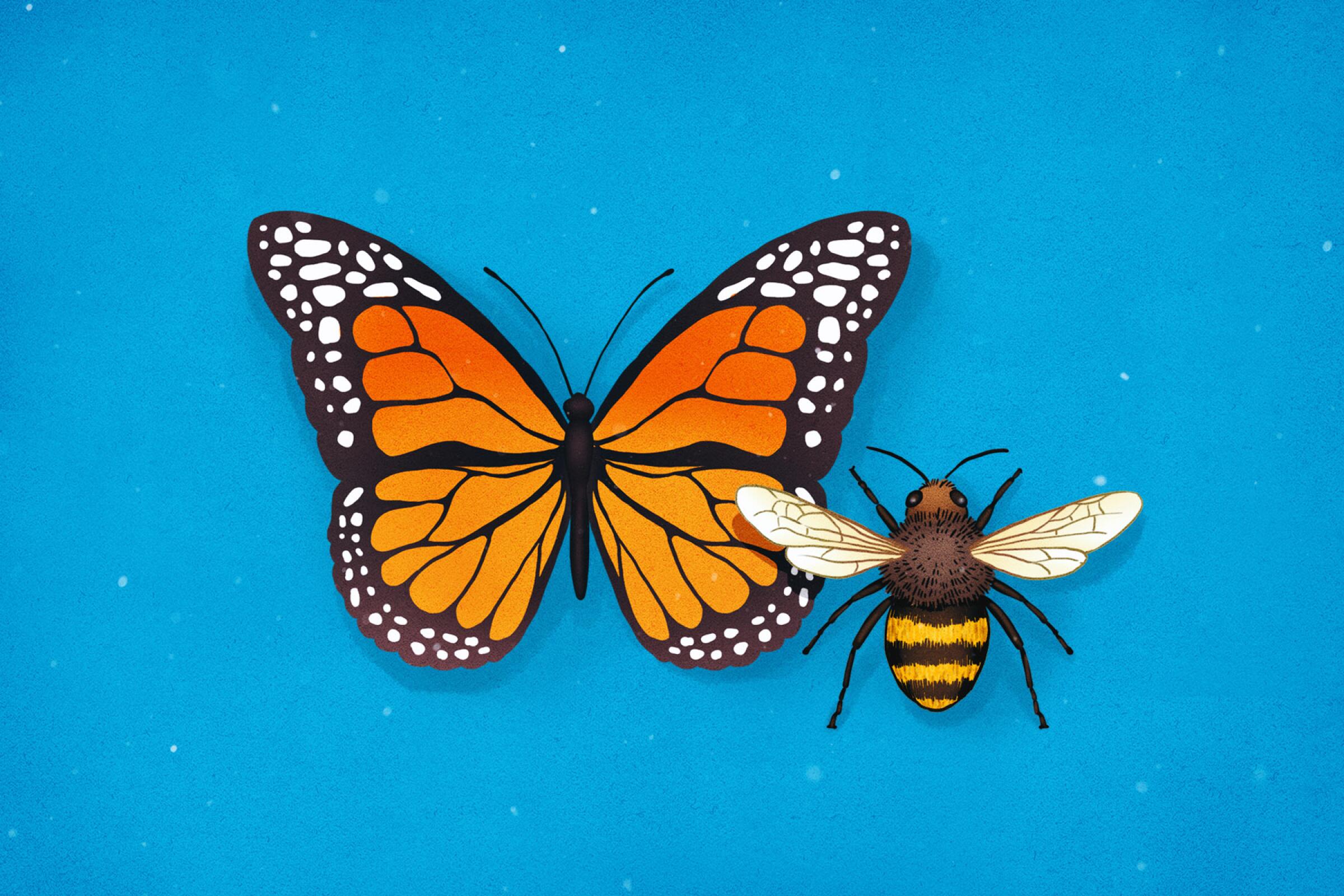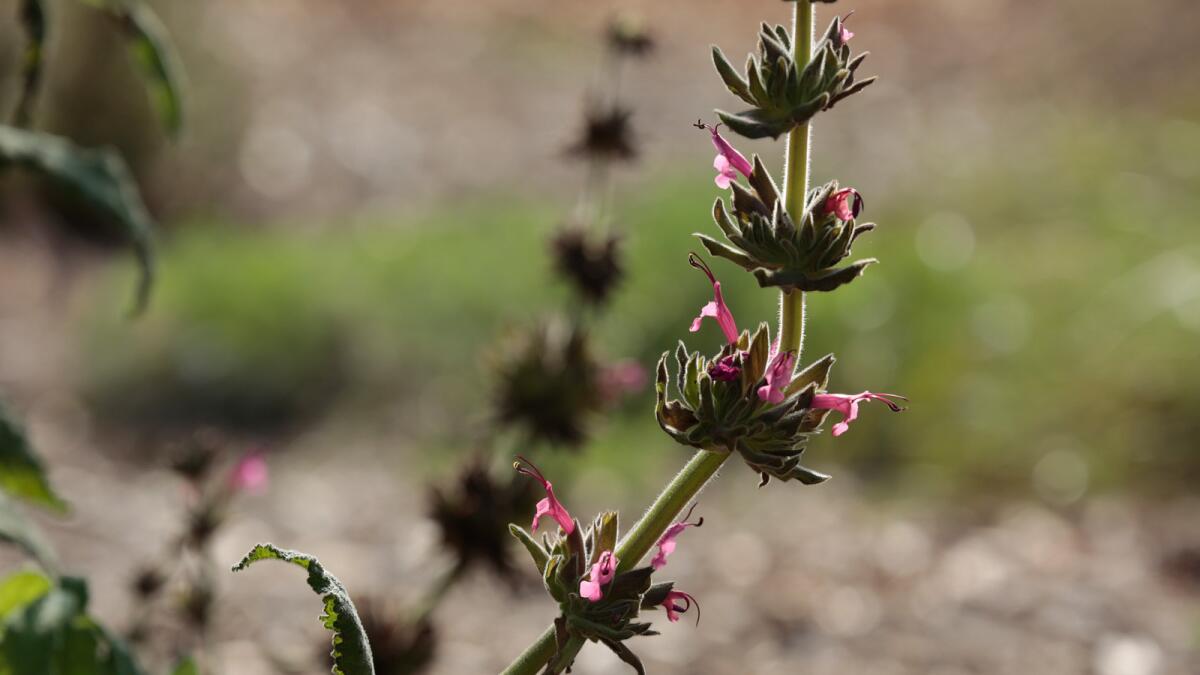Sign up for The Wild
We’ll help you find the best places to hike, bike and run, as well as the perfect silent spots for meditation and yoga.
You may occasionally receive promotional content from the Los Angeles Times.

Once upon a time in Southern California, landscaping was primarily about decoration — the greenest lawn, easy-care sculptural shrubs and a few showstopper flowers, almost none native to the region or welcoming to butterflies and bees.
In truth, we did everything we could to keep bugs out of our yards, and it worked — far too well. Yes, mosquitoes continue to breed in standing water, but when is the last time you saw moths dancing around a city porch light or scraped insects off your windshield?
Bees, butterflies and other native insects are dwindling because they’re running out of the habitat and food provided by native plants. If we want to save them — and the birds and other animals that need those insects to survive — we need to change how we think about landscaping, said Ron Vanderhoff, vice president of the Orange County Chapter of the California Native Plant Society and general manager of the Roger’s Gardens nursery in Corona del Mar.
“There’s been a mind change where gardening is not just decorating, it’s doing something to help the world,” Vanderhoff said. “It’s gardening with a purpose to it.”
Native plants are best adapted to grow in Southern California’s often nutrient-poor soils; they require little water once they’re established, making them ideal for water-wise yards. But the goal goes beyond water conservation: The idea is to make your yard more a habitat that supports a range of life, from native plants and insects to the lizards, birds, toads, bats, possums and everything else that feeds on them, Vanderhoff said.
That doesn’t mean you can’t use other plants; it’s just making a conscious choice to incorporate as many native plants as possible into your landscape.
It also means learning to live with insects in your yard, such as the caterpillars that become the beautiful moths and butterflies we enjoy. “If you never want chew marks on any plant at all, you need to know that’s not how the world works,” Vanderhoff said. “For the birds to eat something, the caterpillars have to eat something. It’s kind of a fantasy to think we can have butterflies without caterpillars.”
When Vanderhoff talks about helping butterflies and bees, he’s not referring to honey bees, which came to the U.S. from Europe. Honey bees are vital to pollinating our nation’s crops, he said, but they are not a food source for native birds and animals. Instead, we need to add native plants that support the 1,600 species of native bees found in California (more than a third of the 4,000 native bee species in the United States, according to University of California journal California Agriculture).
Elizabeth Wallace, an Orange County California Native Plant Society board member and author of the Buckwheat Brings Butterflies blog, has been interested in California’s native flora since she moved from the Midwest 30 years ago. She began feeling urgency about restoring habitat after reading the research of Doug Tallamy, a professor in the department of entomology and wildlife ecology at the University of Delaware and author of “Nature’s Best Hope” and “Bringing Nature Home: How Native Plants Sustain Wildlife in Our Gardens.”
“He counted how many caterpillars mother chickadees need to bring to their nests for little chickadees to fledge and leave the nest, and it’s like 6,000 to 9,000 caterpillars,” Wallace said. “I’ve experienced that in my yard, listening to the babies cry when their mother comes, and I always wondered where they find enough insects to feed those baby birds, and it’s from the native plants. Our insects are suffering because they can’t eat foliage from ornamental plants from Africa, and if the insects disappear, who’s going to feed the birds and the lizards and all the other wildlife?”
When Dave Ethington inherited his parents’ San Clemente home in 2015, it was part gift, part nightmare.
There are nearly 8,000 plants native to California, but this is a big state, and plants that work in Northern California don’t always grow well in SoCal. That’s why the California Native Plant Society has created its Calscape database, which allows Californians to search for plants that are native to their specific region. The database is also searchable by plant name and type, and provides a handy list of local nurseries where that plant is sold.
It’s easy to get overwhelmed by all the choices. Wallace and fellow board member Kris Ethington, winner of Orange County’s 2018 California Friendly Garden contest for relandscaping her entire yard with only native plants, have a list of favorites, including Lemonade Berry, with its showy clusters of pink and white blooms; toyon, aka the California Christmas Berry, with its clusters of bright red, bird-pleasing berries in December; De La Mina verbena, whose cheerful violet blooms attract butterflies year-round; and oak trees, which provide food for at least six native butterfly species.
To help you choose, here is a list of native plants Vanderhoff, Ethington and Wallace consider must-haves in every garden, for their beauty as well as their attractiveness to a variety of native insects.
California buckwheat
If you’re going to plant just one native species in your yard, make it California buckwheat, Wallace said. The native plant society is so sold on this plant’s versatility and beauty that it started distributing free Dana Point varieties all over Orange County as part of its “A Buckwheat in Every Garden” program.
Mike Evans, owner of Tree of Life nursery for native plants in San Juan Capistrano, discovered this smaller-sized buckwheat in Dana Point and took a clipping to create new plants that would more easily fit in urban gardens. California buckwheat is easy to grow and requires little water once established. Dana Point blooms profusely in late spring and summer with creamy white flowers that attract butterflies and other pollinators.

Salvias, a.k.a. sage
Technically, all sages are salvias, but salvias are usually more ornamental plants whereas sage varieties have more culinary or medicinal properties. The Calscape database lists 170 types of sage native to California and 89 types of salvia, so you have plenty of choices in leaves, blooms and growing requirements.
Some, like white sage, thrive in hot dry conditions and have traditional medicinal and culinary uses; others, such as the deep magenta flowers of hummingbird sage, are beloved by pollinators and prefer shady areas. If you have room for only one salvia, however, Vanderhoff recommends the fragrant Cleveland sage. Insects flock to its pale purple spikes and the plant thrives in most parts of Southern California, he said.
Native, narrow-leaf milkweed
Lots of people plant milkweed because it is the primary food source for threatened monarch butterflies. Up until recently, most people planted the showy, orange-flowered tropical varieties that are not native to California. Butterflies flock to the plant, Vanderhoff said, but researchers have discovered that the tropical milkweed supports a tiny protozoa ingested by caterpillars that makes the adult monarchs sickly and weak. For that reason, Vanderhoff’s nursery, Roger’s Gardens, no longer sells anything but the native narrow-leaf milkweed, he said.
Last year Roger’s Gardens gave gardeners a free native narrow-leaf milkweed plant for every tropical milkweed they pulled from their garden and brought to the nursery, Vanderhoff said, and he expects that offer to be repeated in the spring. The narrow-leaf milkweed has whitish flowers and is not as showy as its tropical cousin, but it’s still popular with monarchs and many other beneficial insects.
Ceanothus, a.k.a. California lilac
With its great clusters of purplish flowers, ceanothus is attractive to native insects, especially butterflies, said Wallace. Ceanothus grow quickly and require little water once they’re established. Most love the sun but be aware some of the bushes, such as the popular Ray Hartman variety, can get up to 15 feet tall and 10 feet wide, she said, so plan accordingly. The Yankee Point ceanothus prefers shade and grows closer to the ground, sometimes cascading down hills.
Lupine, California poppy and other wildflowers
Most wildflowers grow easily from seed when planted in late fall/early winter, just before a settling rain. Lupine, with purple flower stalks, and orange California poppies blend beautifully in a garden, especially if you want to create a meadow effect. They’re very popular with beneficial insects. You can purchase wildflower seeds from many nurseries. Theodore Payne Foundation for Wild Flowers & Native Plants sells a variety of seeds from its nursery in Sun Valley as well as online.
Manzanitas
With more than 190 native manzanita varieties in California, the only hard decision is what variety to pick. With their sculptural, mahogany-colored limbs and delicate clusters of bell-shaped flowers, manzanitas complement any landscape while feeding a host of native insects, especially bumble bees, said Wallace.
“If anything will turn people toward natives, it’s manzanitas,” she said. “You get one, and then you get hungry for other varieties.” One of the most popular is the Howard McMinn variety, a medium-size shrub with bright green foliage, red bark and pink flowers that appear in late spring. “It is known as ‘Everyman’s manzanita’ for good reason,” says Calscape. “It is tolerant of a ... variety of garden conditions including clay soils, summer watering, pruning and shearing. It is one of the last manzanitas to bloom, so if you have other manzanitas, including a Howard McMinn will extend your manzanita bloom time.”
Sign up for The Wild
We’ll help you find the best places to hike, bike and run, as well as the perfect silent spots for meditation and yoga.
You may occasionally receive promotional content from the Los Angeles Times.